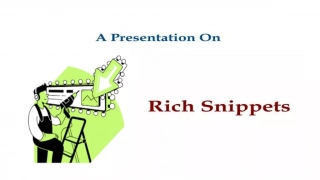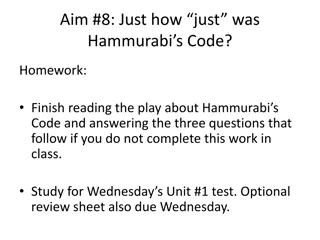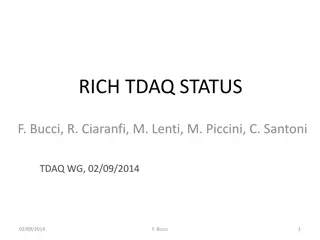Rich snipptes
User intent, also known as search intent or query intent, refers to the underlying goal or purpose behind a user's search query when they use a search engine. It represents what the user is looking to accomplish or find when they enter a specific keyword or phrase into a search engine.
Download Presentation

Please find below an Image/Link to download the presentation.
The content on the website is provided AS IS for your information and personal use only. It may not be sold, licensed, or shared on other websites without obtaining consent from the author. Download presentation by click this link. If you encounter any issues during the download, it is possible that the publisher has removed the file from their server.
E N D
Presentation Transcript
Rich snippets Presented by -komal kashyap
Index- What Are Rich Snippets? How Rich Snippets Help with SEO How to Get Rich Snippets? Types of rich snippets?
What Are Rich Snippets? Rich snippets (also called rich results ) are a type of Google search results that show extra details about your webpage, such as ratings, images, and prices, to help you attract more attention and traffic from search engines. Google typically pulls these extra details from special code (structured data markup) found in the webpage s HTML.
How Rich Snippets Help with SEO- Rich snippets do not directly affect a site's ranking in search results, but they can have indirect benefits. Rich snippets make your pages more visually appealing in the SERPs (search engine results pages). Making them stand out from regular search results. So users are more likely to click rich snippets, improving the organic CTR (click-through rate).
How to Get Rich Snippets- Here s step-by-step guidance on how to get rich snippets: 1. Choose an appropriate rich snippet type 2. Create and add structured data to your pages 3. Validate your structured data
Types of snippets- Review Snippets: These snippets display star ratings and review counts for products, services, businesses, recipes, and other entities. They provide users with quick insights into the quality and popularity of the item. Product Snippets: Product snippets include details such as pricing, availability, and product descriptions. They are commonly used for e-commerce websites and help users compare products directly in search results. Recipe Snippets: Recipe snippets show key information about recipes, including ingredients, cooking time, and ratings. They are especially useful for users searching for specific recipes and cooking instructions. Event Snippets: Event snippets display details about upcoming events, such as event dates, times, locations, and ticket availability. They help users find relevant events and make plans accordingly. FAQ Snippets: FAQ snippets feature frequently asked questions and their corresponding answers directly in search results. They provide users with quick answers to common queries and can increase visibility for websites with helpful FAQ content.
Video Snippets: Video snippets include thumbnails and descriptions for videos hosted on websites like YouTube. They allow users to preview video content directly in search results and encourage clicks to view the full video. Article Snippets: Article snippets showcase key information from news articles, blog posts, and other written content. They typically include the article's title, publication date, and author, along with a brief excerpt or summary. Local Business Snippets: Local business snippets provide details about businesses, including contact information, opening hours, and customer reviews. They help users find and evaluate local businesses quickly and easily. These are just a few examples of the types of rich snippets that can appear in search results. The specific types of rich snippets that appear depend on factors such as the content of the webpage, the structured data markup used, and Google's algorithms. Using structured data markup effectively can increase the likelihood of rich snippets appearing for your website's content in search results. Video Snippets: Video snippets include thumbnails and descriptions for videos hosted on websites like YouTube. They allow users to preview video content directly in search results and encourage clicks to view the full video. Article Snippets: Article snippets showcase key information from news articles, blog posts, and other written content. They typically include the article's title, publication date, and author, along with a brief excerpt or summary. Local Business Snippets: Local business snippets provide details about businesses, including contact information, opening hours,and customer reviews. They help users find and evaluate local businesses quickly and easily. These are just a few examples of the types of rich snippets that can appear in search results. The specific types of rich snippets that appear depend on factors such as the content of the webpage, the structured data markup used, and Google's algorithms. Using structured data markup effectively can increase the likelihood of rich snippets appearing for your website's content in search results.
conclusion- In conclusion, rich snippets play a vital role in enhancing the search experience for users by providing additional information directly in search engine results pages (SERPs). By incorporating structured data markup into their webpages, website owners can increase the likelihood of rich snippets appearing, thereby improving the visibility and click-through rates of their content. Rich snippets come in various forms, including review snippets, product snippets, recipe snippets, event snippets, FAQ snippets, video snippets, article snippets, and local business snippets. Each type of rich snippet serves a specific purpose, providing users with relevant and actionable information that helps them make informed decisions and find what they're looking for more quickly. For website owners, leveraging rich snippets can lead to several benefits, including increased visibility in search results, higher click-through rates, improved user























